
In his book “Developmental Politics,” Steve McIntosh develops a new political philosophy to help overcome the extreme hyper-polarization that plagues western democracies — the United States in particular. He argues that there is a cultural war raging between the proponents of major value systems that have emerged throughout history. In his view, the values of “traditionalism,” “modernism,” and “postmodernism” form the central “bedrock values” of the American society (and comparable Western societies).
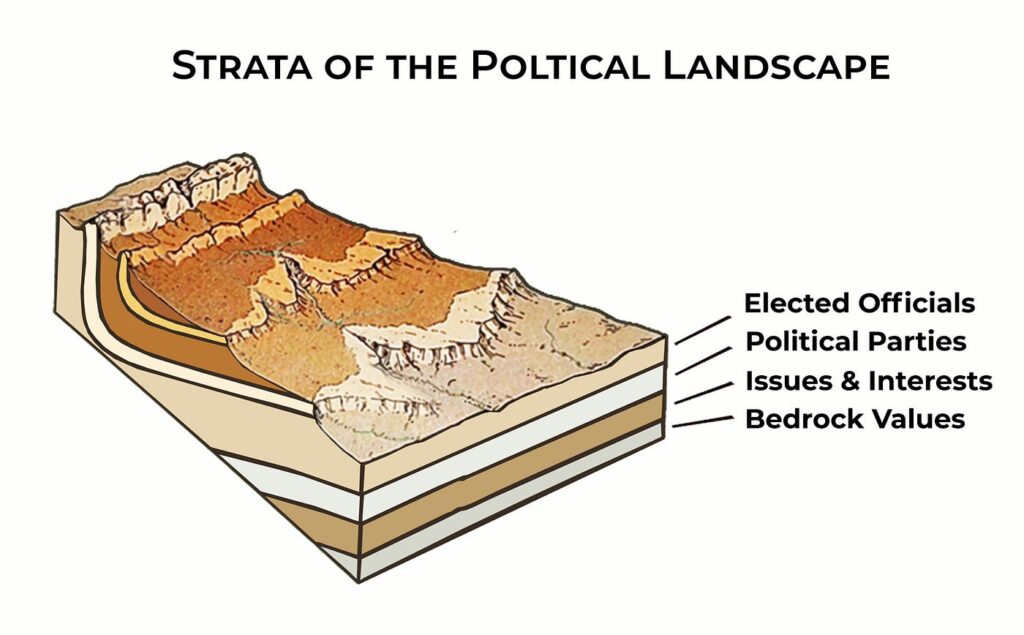
Modernism itself has, over time, further divided into two camps in the United States: “Liberal Modernists” and “Fiscally Conservative Modernists.”
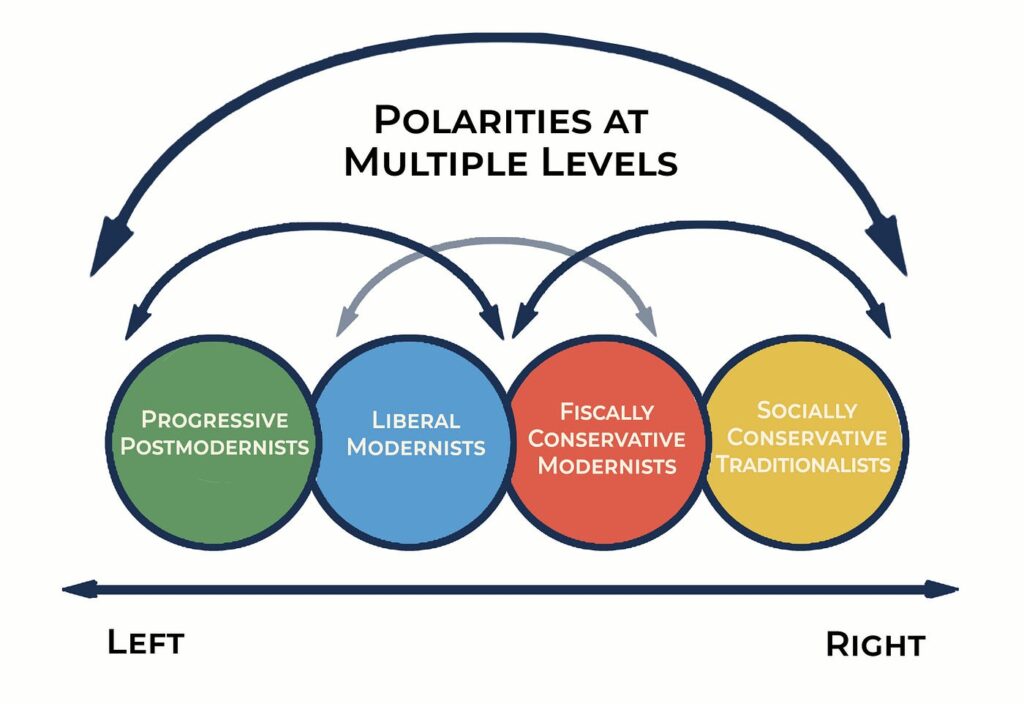
The problem is that these camps are at each other’s throats. The challenge is to encompass them in a higher order system that honours the strengths of each worldview, while at the same time preventing their excesses.
McIntosh views these value systems as existing in both a developmental as well as a polar relationship with each other. By referencing the theory of polarity management, he points out that in any polarity in which both poles are positive, no one pole can ever “win” since both poles challenge as well as complement each other. Each pole has its upsides and downsides, as summarised in this diagram.

Getting rid of, say, traditional values doesn’t help postmodern values, because it would rob society of the social cohesion and order that is ultimately required for postmodern values to emerge in the first place. Likewise, modernism “winning” against postmodern environmentalism would maybe enhance some people’s profits in the short term, but ultimately saw off the branch we’re sitting on in terms of the carrying capacity of the planet.
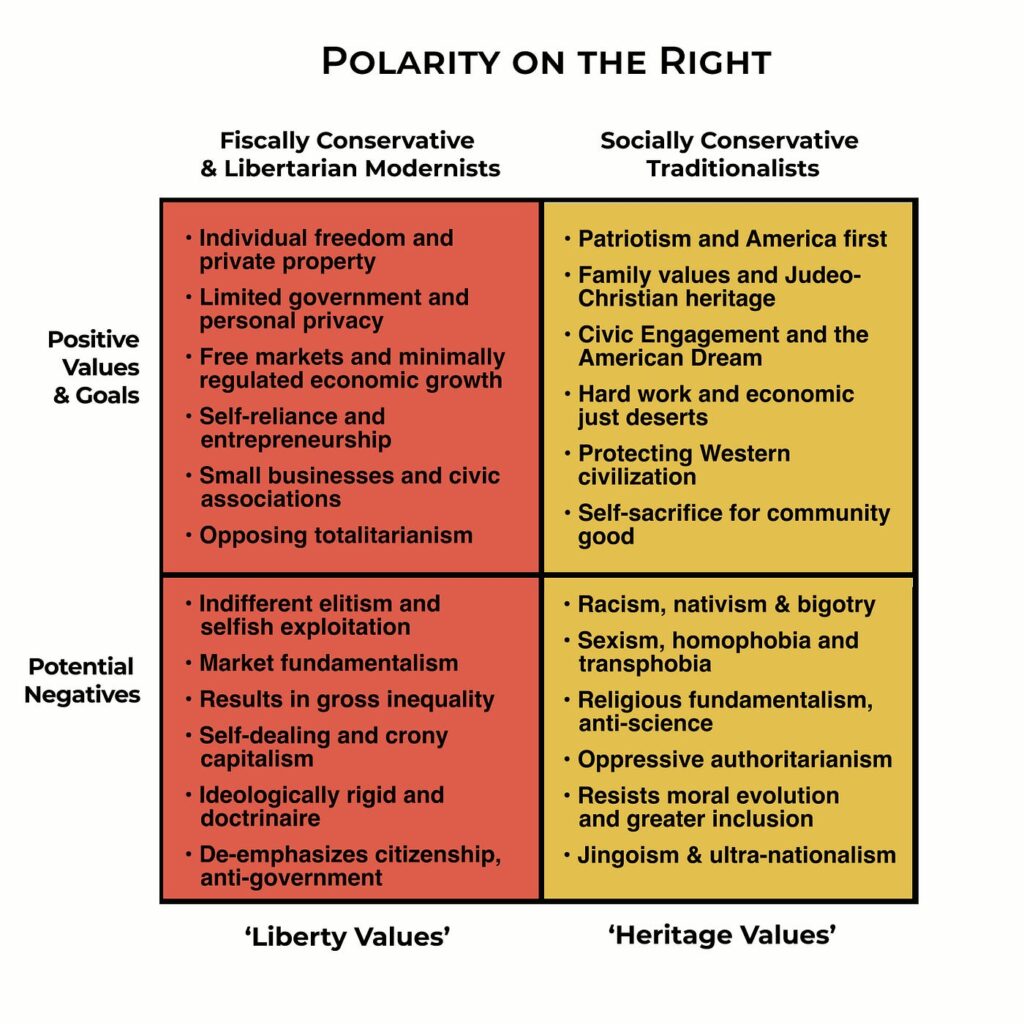
Now, all of these values have emerged for good reasons and need to be harmonised in an overall system for each of them, and the greater whole of society, to be able to flourish. None of them can be safely excluded from having a seat at the political table — nor should they be flippantly discarded. Instead, polarities of this kind have to be continuously managed.
Values Integration
McIntosh calls the corresponding political process “values integration.” Apart from the issue of marijuana legalization, he gives the example of gay marriage to illustrate how an additive process of including all “bedrock values” can lead to wider social acceptance of new policies:
Advocacy for the right to marry has been instrumental in the larger success of the gay rights movement overall because the cause of gay marriage integrates important values from each of the four major value systems illustrated by the
charts. Gay marriage advances caring values, fairness values, liberty values, and crucially, traditional family values (heritage values). Traditionalist who otherwise object to “decadent homosexual lifestyles” find it much harder to
resist calls for the basic right to make a family commitment through the institution of marriage. While perceived traditionalist interests are not included in the new right for gays to marry, traditionalist values are included nonetheless. It was thus through values integration that this previously polarized issue has not only become law, it has also gained widespread social acceptance.
It’s a bit like playing guitar: if you don’t hit all the strings, the chord just won’t sound as good as it could.
A Robust Political Process for Integrating Values
While McIntosh does a great job of providing a broad outline and the philosophical underpinnings for how this higher integration might occur, he is less clear about what specific process could be used to make day-to-day political decisions.
That said, my guiding questions for this exploration were:
What are the conditions for integrating representatives of these value systems in a political decision-making process that is both constructive and has the potential to honour the fundamental concerns of each party involved?
How can we make sure that each party can bring their gifts while relying on the watchfulness of the other value systems to curb their potential excesses (the negative aspects of their value pole), whenever needed?
How can we design a decision-making process that implicitly teaches the value of each of the bedrock values to the other parties?
How can we integrate the wisdom of all these perspectives while avoiding political stalemates and ideological trench warfare?
Luckily, we don’t have to completely reinvent the wheel when it comes to decision-making processes. From my background as a Holacracy Coach, I am very familiar with the Integrative Decision-Making process (IDM) that is used during governance meetings to integrate conflicting views on the best way forward in organizations. My sense is that by tweaking and experimenting with this process, it can be successfully exported to work as an initial answer to the questions raised above.
Integrative Decision-Making
IDM is a robust process that is described in detail in the Holacracy Constitution. It reliably leads to workable outputs that have been checked for potential harm. It does so by following clearly delineated rules. An elected Facilitator ensures that the circle (the team) sticks to the rules of the process.
Essentially, IDM is a recipe for a well-run and civil discussion which is highly outcome-focused.
Here’s an excerpt from the Holacracy Constitution (v5.0):
§5.4.5 Integrative Decision-Making Process
The Facilitator must enact the “Integrative Decision-Making Process” as follows:
• (a) Present Proposal: First, the Proposer may describe the Tension and present a Proposal to address it. On the Proposer’s request, the Facilitator may allow others to help craft a Proposal. However, the Facilitator must focus this help solely on getting to an initial Proposal to address the Proposer’s Tension. The Facilitator must disallow discussing other Tensions or concerns about the Proposal.
• (b) Clarifying Questions: Once the Proposer makes a Proposal, others may ask questions to better understand the Proposal or the Tension behind it. The Proposer may answer each question, or may decline to do so. The Facilitator must stop any reactions or opinions expressed about the Proposal, and prevent discussion of any kind. Participants may also ask the Secretary to read the Proposal or show any existing Governance, during this step or at any other time when the participant is allowed to speak, and the Secretary must do so.
• (c) Reaction Round: Next, each participant except the Proposer may share reactions to the Proposal, one person at a time. The Facilitator must immediately stop any out-of-turn comments, any attempts to engage others in a dialog, and any reactions to other reactions instead of to the Proposal.
• (d) Option to Clarify: Next, the Proposer may share comments in response to the reactions and make amendments to the Proposal. However, the primary intent of any amendments must be to better address the Proposer’s Tension, and not Tensions raised by others. The Facilitator must immediately stop comments by anyone other than the Proposer or Secretary. Any engagement by the Secretary must focus solely on capturing the amended Proposal.
• (e) Objection Round: Next, each participant, one at a time, may raise concerns about adopting the Proposal. The Facilitator must either capture these concerns as Objections, or test them to see if they meet the Objection criteria and capture any that do. If there are no Objections, the Proposal is adopted. While testing concerns and capturing Objections, the Facilitator must stop and disallow discussion or responses of any kind from anyone other than the Objector.
• (f) Integration: If there are Objections, the Facilitator then focuses on each one, one at a time. For each, the participants brainstorm to find a potential amendment to the Proposal to resolve the Objection. The Facilitator marks an Objection resolved once the Objector confirms that the amended Proposal would not trigger the Objection, and the Proposer confirms that it still addresses the Tension. During this step, the Facilitator must apply the rules of integration described in this Article. Once all Objections are resolved, the Facilitator moves back to the Objection round with the amended Proposal.
A key piece of the process is the Objection Round (e), sometimes also called the “safety check” of the proposal. Here the Facilitator asks each person whether they have concerns with regard to the proposal. In an organizational context, each person speaks as a sensor for the organizational role it is inhabiting, sensing into whether the proposed change would hinder them in expressing the purpose or accountabilities of their roles. In this way, this step acts as a safety net, eliciting concerns from the group before the proposal gets implemented. But not every concern necessarily constitutes an objection that needs to be integrated. That’s why the Facilitator tests the concerns according to the following four criteria.
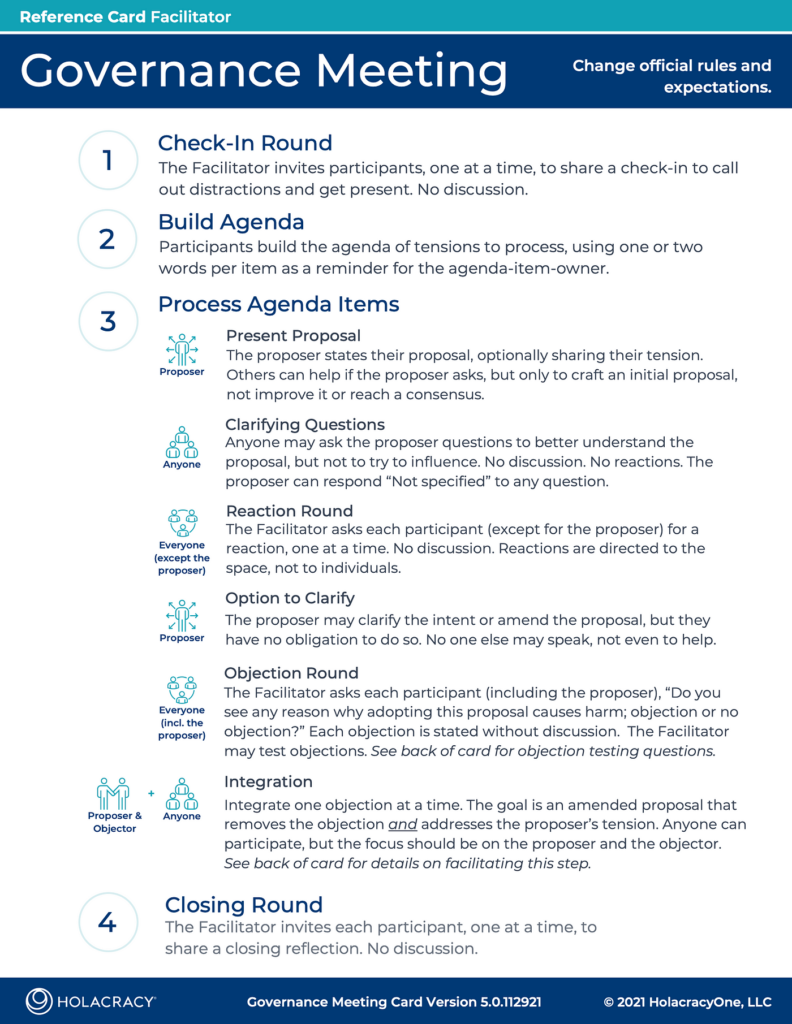
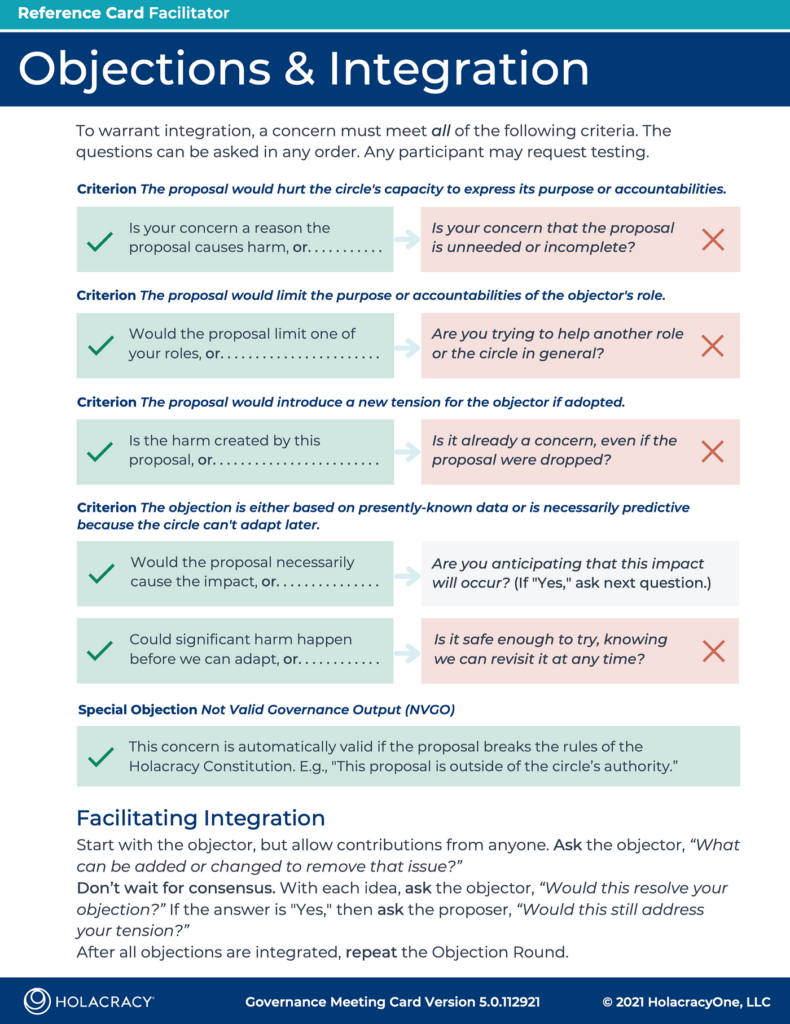
§5.3.2 Objection Requirements
A concern about adopting a Proposal only counts as an Objection if the Objector can provide a reasonable argument for why it meets all of the following criteria:
• (a) The Proposal would reduce the capacity of the Circle to enact its Purpose or Accountabilities.
• (b) The Proposal would limit the Objector’s capacity to enact the Purpose or an Accountability of a Role the Objector represents in the Circle, even if the Objector filled no other Roles in the Organization.
• (c) The concern does not already exist even in the absence of the Proposal. Thus, a new Tension would be created specifically by adopting the Proposal.
• (d) The Proposal would necessarily cause the impact, or, if it might cause the impact, the Circle wouldn’t have an adequate opportunity to adapt before significant harm could result.
However, regardless of the above criteria, a concern always counts as an Objection if adopting the Proposal would violate a rule in this Constitution.
§5.3.3 Testing Potential Objections
The Facilitator may test whether a concern counts as an Objection by asking the Objector if the concern meets the required criteria, and how. When assessing responses, the Facilitator may only judge whether the Objector presented arguments for each criteria using logical reasoning. The Facilitator may not judge on the basis of an argument’s accuracy or the importance of addressing it.
Necessary adaptations of the IDM process for a political context
These rules work in a certain context: that of Holacracy, a role-based organizational operating system. To make it work in a political context, some of the basic parameters would have to be tweaked.
In Holacracy, people are sensors on behalf of their organizational roles.
In the adapted version of the process, people would act as sensors on behalf of one of the essential bedrock values. Usually, that’s what politicians have been voted into office for — to represent a certain set of values (often regardless of particular political platforms, policies, or election promises).
Before entering the process, participants would self-identify as a “sensor” representing at least one (or more) of the bedrock values from the list above. This would have the beneficial side-effect of implicitly teaching them the contours of the positive expression of all of these value poles (the upper quadrants of the diagrams above) which they often never pause to even consider.
The Facilitator would highlight that while participants can not necessarily expect their preferred solution (their proposal) to be accepted as-is, they can expect their original impulse to resolve a problem and that their bedrock values will be honoured and protected. Every participant will be able to raise objections, and for a proposal to be ultimately adopted, all objections would have to be integrated first.
In Holacracy, the objection requirements act as an effective filter against highly subjective and unproductive objections. It’s not a filibuster situation in Holacracy. There are no personal vetoes that can grind the process to a halt. Objections must be rooted in the organizational role, not just in a personal agenda. Every concern is rigorously tested against the criteria outlined above (§5.3.3). Concerns that do not satisfy all four criteria do not qualify as objections that need to be integrated. They may be independent concerns, but none that would constitute a reason why the proposal on the table would create harm if it was adopted.
To work in a political setting, the objection requirements would have to be modified:
• (a) The Proposal would violate one of the bedrock values as sensed by the value’s representative.
• (b) The concern does not already exist even in the absence of the Proposal. Thus, a new Tension would be created specifically by adopting the Proposal.
• (c) The Proposal would necessarily cause the impact, or, if it might cause the impact, the governing body wouldn’t have an adequate opportunity to adapt before significant harm could result.
As you can see, I replaced the first requirement, erased the second one (it does not really apply), and slightly altered the fourth (now third) requirement.
The test question for criterion (a) might hence sound like this:
“Does the proposal violate a particular bedrock value… OR … do you find it unnecessary or incomplete?”
Further, the Facilitator would ask: “If yes, which value and how?”
Here, an argument needs to be presented by the person raising the concern. It is important to mention that the Facilitator only judges whether a reasoned argument has been presented, not whether they personally agree with it. Presenting a reasoned argument that would justify a violation of the bedrock value in the eyes of the harm-sensor would be sufficient at this point of the testing process to satisfy this criterion.
If the objector merely finds the proposal unnecessary or incomplete, their concern doesn’t constitute an objection according to these rules. Hence, it would be disregarded in the integration step. At this stage, the Facilitator is only testing for harm with regard to bedrock values the representative claims they want to protect.
If a concern has passed the test and qualifies as an objection, this does not mean that it stops the proposal at hand. The tension behind the original proposal is still being honoured. It simply means that the objection raised needs to be integrated during the integration step. The goal of the integration step is to explore the solution space together with the original proposer as well as all the objector(s). They work together as sensors for the specific values they are pursuing. An amended proposal has to satisfy both sides: the proposer and the objector. If there are difficulties or resistance to integration attempts, the “Rules of Integration” (§5.3.4) give the Facilitator some more teeth to arrive at a solution.
This process of joint solution-seeking gets us out of WIN:LOSE territory into WIN:WIN or “OMNI:WIN” territory.
The process described above would give us a basic setup that can be used to run experiments in political contexts where representatives are willing to enter a good-faith dialog to overcome difficult stalemates and reach more integrated solutions.
Obviously, my proposal leaves many questions open, such as who can participate under which condition, how is the Facilitator elected, etc. But it could catalyse a process of experimentation among the open-minded in each party, starting a recursive learning loop in which the rules of the process can be tweaked and refined along the way — similar to the continuous evolution of the Holacracy Constitution. Let me know what you think.
Who knows, maybe it could even be a catalyst to evolve the American Constitution as well?
I would like to thank Steve McIntosh for permission to use the charts from his book “Developmental Politics”.
To learn more about self-management, join a community of pioneers and check out our e-learning suite → Self-Management Accelerator